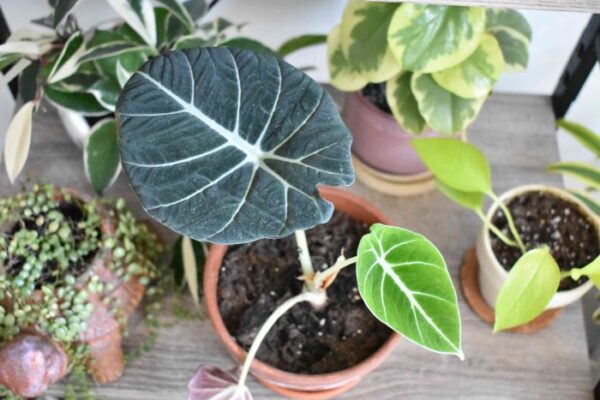Alocasia Black Velvet is a type of tropical plant that is native to Southeast Asia. It is a popular choice among plant enthusiasts due to its stunning black foliage, which stands out in contrast to the green foliage of most other houseplants. With its large, velvety leaves and striking appearance, the Alocasia Black Velvet is a unique and attractive addition to any indoor garden.
The Alocasia Black Velvet is also known as the Elephant Ear plant, due to the shape of its leaves, which resemble the ears of an elephant. The leaves are a glossy black color and can grow up to one foot in length. In addition to its beautiful foliage, the Alocasia Black Velvet also produces small, purple flowers that bloom in the summer. These flowers are not as showy as the foliage, but they do add a touch of color to the plant.

Table of Contents
Alocasia Black Velvet Flower
The Alocasia Black Velvet is a tropical plant that is prized for its stunning black foliage. Although it is not grown primarily for its flowers, the plant does produce small, purple flowers that bloom in the summer. These flowers are not as showy as the foliage and are generally considered to be a secondary feature of the plant. The flowers grow on tall spikes and are not as commonly seen as the large, glossy black leaves that are the plant’s main attraction. If you’re looking for a plant that is grown for its flowers, you may want to consider a different species, as the Alocasia Black Velvet is mostly grown for its striking foliage.
Alocasia Black Velvet Care:
When it comes to caring for the Alocasia Black Velvet, it is important to provide it with the right conditions to thrive. The plant prefers a warm, humid environment and requires bright, indirect light. It should be kept away from direct sunlight, as this can cause the leaves to scorch and turn yellow. Watering is also important, as the plant does not like to be kept too dry or too moist. It is best to water the plant when the top inch of soil is dry to the touch, and it is also a good idea to mist the leaves to help increase humidity.
In terms of soil, the Alocasia Black Velvet prefers a well-draining potting mix that is rich in organic matter. A mixture of peat moss, perlite, and vermiculite works well for this plant. It is also important to repot the Alocasia Black Velvet every few years, as it can outgrow its container. When repotting, be sure to use a pot that is one size larger than the previous one, and make sure to loosen the roots so that they can spread out in the new soil.
In terms of pests and diseases, the Alocasia Black Velvet is relatively low maintenance. However, it is susceptible to spider mites, which can cause yellow spots on the leaves and cause the plant to become stunted. To prevent spider mites, it is important to keep the plant clean and dry, and to regularly check for any signs of infestation. Additionally, it is important to avoid overwatering the plant, as this can cause root rot, which can be fatal.
Why alocasia black velvet leaves are curling
There are several reasons why the leaves of an Alocasia Black Velvet plant may be curling:
- Overwatering: If the soil is consistently too moist, the roots of the plant may be oxygen-starved, causing the leaves to curl. Make sure to allow the soil to dry out somewhat between waterings.
- Underwatering: On the other hand, if the soil is too dry, the leaves may also curl as a sign of stress. Make sure to water the plant when the top inch of soil is dry to the touch.
- Low humidity: The Alocasia Black Velvet plant prefers a humid environment, so if the air is too dry, the leaves may start to curl. Consider using a humidifier or misting the leaves regularly to increase humidity.
- Too much direct sunlight: Direct sunlight can cause the leaves to scorch, which can cause them to curl. Make sure to place the plant in bright, indirect light.
- Pests: Infestations of pests such as spider mites or aphids can cause the leaves to curl and become stunted. Regularly inspect the plant for any signs of pests and treat them promptly.
- Disease: Certain diseases, such as root rot, can cause the leaves to curl and become stunted. Make sure to avoid overwatering the plant and to provide good drainage to prevent root rot.
If the leaves of your Alocasia Black Velvet plant are curling, it is important to identify and address the cause as soon as possible to keep the plant healthy and thriving.
In conclusion, the Alocasia Black Velvet is a beautiful and unique houseplant that is sure to make a statement in any indoor garden. With its large, glossy black leaves and striking appearance, it is a must-have for any plant enthusiast. However, it is important to provide it with the right conditions and proper care to keep it healthy and thriving. With its beauty and low maintenance needs, the Alocasia Black Velvet is the perfect addition to any indoor collection.

Holding a Ph.D. in Botany and boasting over 15 years of experience in horticulture and plant science, our author stands as a top authority on plant care and gardening. Their dedication to sustainable gardening practices and thriving greenery shines through on egreenplants.com, where they share their extensive knowledge and personal insights. Whether it’s mastering plant cultivation techniques or offering expert advice on plant care, their guidance ensures gardening enthusiasts receive reliable and actionable information. Follow their green journey on Instagram at @plantsandrocks for more tips and inspiration.

